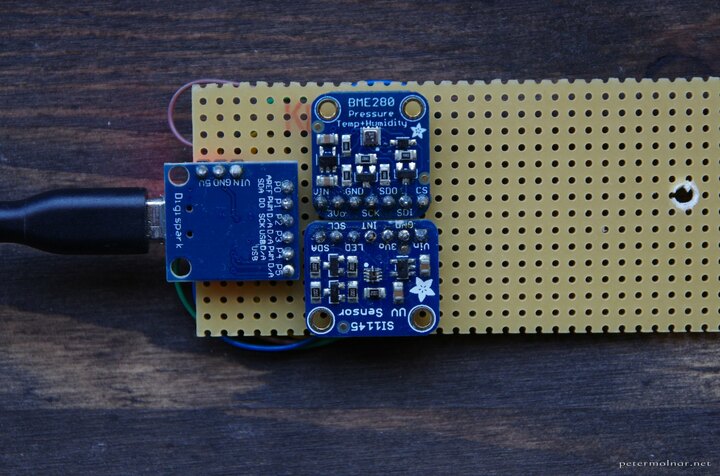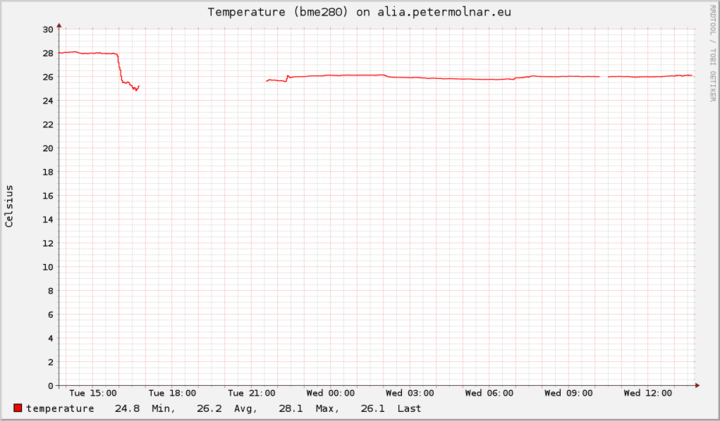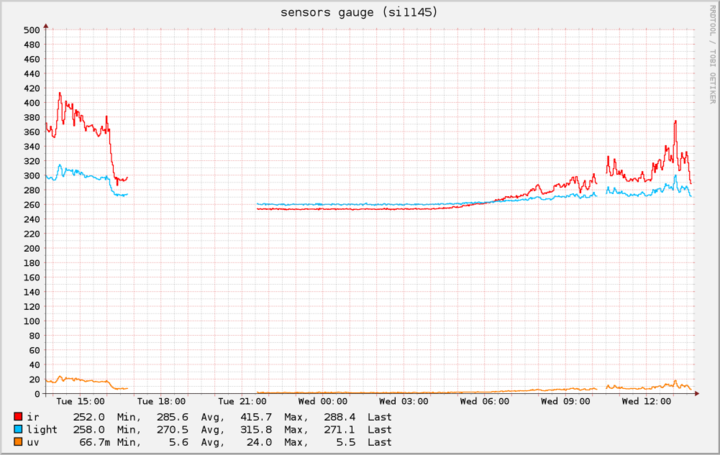Notes: no warranties. This is hardware, so it can cause trouble with your system, especially if you short-circuit something or - as I did once, many moons ago - solder on the fly why the thing is still connected to the USB port. Don't do that.

USB I²C adapter
A few months ago I wrote about using a Raspberry Pi with some I²C sensors to collect data for Collectd1. While it worked well, it made me realise that having the RPi running a full fledged operating system means I need to apply security patches to yet another machine, and that is not something I want to deal with. I also have a former laptop, running as a ZFS based NAS, so why not use that?
After venturing into a fruitless dig to use the I²C port in the VGA connector2 I verified that indeed, as concluded in the tutorial, it doesn't work with embedded Intel graphics on linux.
Alternative I started looking at USB I²C adapter, but they are expensive. There is one project though, which looked very promising, and it didn't require a full-fledged Arduino either: Till Harbaum's I²C-Tiny-USB3.
It uses an ATtiny85 board - as the name suggests, it's tiny, and turned out to be a perfectly fine USB to I²C adapter. You can buy one here: https://amzn.to/2ubPs6I
Note: there's an Adafruit FT232H, which, in theory, is capable of the same thing. I haven't tested it.
I2C-Tiny-USB firmware
The git repository already contains a built hex file,
but in case there are any modifications needed to be done, this is how
it's done:
sudo -i
apt install gcc-avr avr-libc
cd /usr/src
git clone https://github.com/harbaum/I2C-Tiny-USB
cd I2C-Tiny-USB/digispark
make hexMake sure the I2C_IS_AN_OPEN_COLLECTOR_BUS is
uncommented; I've tried with real pull-up resistors, and, for my
surprise, the sensors stopped showing up.
micronucleus flash utility
To flash the hex file, you'll need micronucleus, a tiny
flasher utility.
sudo -i
apt install libusb-dev
cd /usr/src
git clone https://github.com/micronucleus/micronucleus
cd micronucleus/commandline
make CONFIG=t85_default
make installRun:
micronucleus --run --dump-progress --type intel-hex main.hexthen connect the device through a USB port, and wait for the end of the flash process.
I²C on linux
Surprisingly enough, Debian did not show I²C hubs in
/dev - apparently the kernel module for this is not loaded,
so load it, and make that load permanent:
sudo -i
modprobe i2c-dev
echo "i2c-dev" >> /etc/modulesConnect the Attiny85
Normally a PC already has a serious amount of I²C adapters. As a result, the new device will show up with an extra device number, which number is rather important. The kernel log can help identify that:
dmesg | grep i2c-tiny-usb
[ 3.721200] usb 5-2: Product: i2c-tiny-usb
[ 3.725693] i2c-tiny-usb 5-2:1.0: version 2.01 found at bus 005 address 003
[ 3.736109] i2c i2c-1: connected i2c-tiny-usb device
[ 3.736584] usbcore: registered new interface driver i2c-tiny-usbTo read just the device number:
i2cdev=$(dmesg | grep 'connected i2c-tiny-usb device' | head -n1 | sed -r 's/.*\s+i2c-([0-9]+).*/\1/')Note: the device number might change after a reboot. For me,
it was 10 when simply plugged in, and 1 if it
was connected during a reboot.
Detecting I2C devices
i2cdetect is a program that dumps all the devices
responding on an I²C adapter. The Adafruit website has a collection for
their sensors4. That 1 after the
i2cdetect -y is the device number identified in the
previous step, and it says I have 2 devices:
sudo -i
i2cdev=$(dmesg | grep 'connected i2c-tiny-usb device' | head -n1 | sed -r 's/.*\s+i2c-([0-9]+).*/\1/')
i2cdetect -y ${i2cdev}
0 1 2 3 4 5 6 7 8 9 a b c d e f
00: -- -- -- -- -- -- -- -- -- -- -- -- --
10: -- -- -- -- -- -- -- -- -- -- -- -- -- -- -- --
20: -- -- -- -- -- -- -- -- -- -- -- -- -- -- -- --
30: -- -- -- -- -- -- -- -- -- -- -- -- -- -- -- --
40: -- -- -- -- -- -- -- -- -- -- -- -- -- -- -- --
50: -- -- -- -- -- -- -- -- -- -- -- -- -- -- -- --
60: 60 -- -- -- -- -- -- -- -- -- -- -- -- -- -- --
70: -- -- -- -- -- -- -- 77 I²C 0x77: BME280 temperature, pressure, humidity sensor5
This is where things got interesting. Normally, when a
BME280 sensors comes into play, every tutorial starts
pulling out Python for the task, given that most of the Adafruit
libraries are in Python.
Don't get me wrong, those are great libs, and the Python solutions
are decent, but doing a pip3 search bme280 resulted in
this:
bme280 (0.5) - Python Driver for the BME280 Temperature/Pressure/Humidity Sensor from Bosch.
Adafruit-BME280 (1.0.1) - Python code to use the BME280 temperature/humidity/pressure sensor with a Raspberry Pi or BeagleBone black.
adafruit-circuitpython-bme280 (2.0.2) - CircuitPython library for the Bosch BME280 temperature/humidity/pressure sensor.
bme280_exporter (0.1.0) - Prometheus exporter for the Bosh BME280 sensor
RPi.bme280 (0.2.2) - A library to drive a Bosch BME280 temperature, humidity, pressure sensor over I2CWhich one to use? Then there are the dependencies, and the code quality varies from one to another.
So I started digging into the internet, github, and other sources,
and somehow I realised there's a kernel module, named
bmp280. The BMP280 is a sibling of the
BME280 - it's without the humidity sensor. So the questions
was: what in the world is drivers/iio/pressure/bmp280-i2c.c
and how can I use it?
It turned out, that apart from hwmon, there's another
sensor library layer in the linux kernel, called Industrial I/O - iio.
It was added with this name somewhere in 2012, around 3.156,
and it's purpose is to offer a subsystem fast speed sensors7. While fast speed is not a thing for
me this time, but I do trust the kernel code quality.
For my greatest surprise, the BMP280 module is even
included in the Debian Sid kernel as a module, and adding it was a
mere:
sudo -i
modprobe bmp280
echo "bmp280" >> /etc/modules
modprobe bmp280-i2c
echo "bmp280-i2c" >> /etc/modulesTo actually enable the device, the i2c bus has to be told of the sensor's existence:
sudo -i
i2cdev=$(dmesg | grep 'connected i2c-tiny-usb device' | head -n1 | sed -r 's/.*\s+i2c-([0-9]+).*/\1/')
echo "bme280 0x77" > /sys/bus/i2c/devices/i2c-${i2cdev}/new_deviceThe kernel log should show something like this:
kernel: bmp280 1-0077: 1-0077 supply vddd not found, using dummy regulator
kernel: bmp280 1-0077: 1-0077 supply vdda not found, using dummy regulator
kernel: i2c i2c-1: new_device: Instantiated device bme280 at 0x77Verify the device is working:
tree /sys/bus/iio/devices/iio\:device0
/sys/bus/iio/devices/iio:device0
├── dev
├── in_humidityrelative_input
├── in_humidityrelative_oversampling_ratio
├── in_pressure_input
├── in_pressure_oversampling_ratio
├── in_pressure_oversampling_ratio_available
├── in_temp_input
├── in_temp_oversampling_ratio
├── in_temp_oversampling_ratio_available
├── name
├── power
│ ├── async
│ ├── autosuspend_delay_ms
│ ├── control
│ ├── runtime_active_kids
│ ├── runtime_active_time
│ ├── runtime_enabled
│ ├── runtime_status
│ ├── runtime_suspended_time
│ └── runtime_usage
├── subsystem -> ../../../../../../../../../bus/iio
└── uevent
2 directories, 20 filesAnd that's it. The BME280 is ready to be used:
for f in in_pressure_input in_temp_input in_humidityrelative_input; do echo "$f: $(cat /sys/bus/iio/devices/iio\:device0/$f)"; done
in_pressure_input: 102.112671875
in_temp_input: 26050
in_humidityrelative_input: 49.611328125According to the BME280 datasheet8,
under recommended modes of operation (3.5.1 Weather monitoring), the
oversampling for each sensor should be 1, so:
sudo -i
echo 1 > /sys/bus/iio/devices/iio\:device0/in_pressure_oversampling_ratio
echo 1 > /sys/bus/iio/devices/iio\:device0/in_temp_oversampling_ratio
echo 1 > /sys/bus/iio/devices/iio\:device0/in_humidityrelative_oversampling_ratioI²C 0x60: SI1145 UV index, light, IR sensor9
Unlike the BME280, the SI1145 doesn't have a built-in kernel module in Debian Sid - but it does exist as a kernel module, it's simply not included in the Debian Kernel. I've also learnt that this sensor is a heavyweight player, and that I should have bought something way simpler for mere light measurements; something that's already included the out-of-the-box kernel modules, like a TSL256110.
But I wasn't willing to give up the SI1145, being an expensie sensor, so in order to have it in the kernel, I had to compile the kernel module. Before getting started make sure:
- your system is up to date
- you have rebooted since the last kernel update
Once those two are true, identify the kernel version:
uname -a
Linux system-hostname 4.17.0-1-amd64 #1 SMP Debian 4.17.3-1 (2018-07-02) x86_64 GNU/LinuxThe output contains 4.17.3-1 - that is the
actual kernel version, not the 4.17.0-1-amd64
which is the Debian name.
Get the kernel; extract it; add the SI1145 to the config; compile the
drivers/iio/light modules; add that to the local
modules.
sudo -i
cd /usr/src/
wget https://cdn.kernel.org/pub/linux/kernel/v4.x/linux-4.17.3.tar.gz
tar xf linux-4.17.3.tar.gz
cd linux-4.17.3
cp /boot/config-4.17.0-1-amd64 .config
cp ../linux-headers-4.17.0-1-amd64/Module.symvers .
echo "CONFIG_SI1145=m" >> .config
make menuconfig
# save it
# exit
make prepare
make modules_prepare
make SUBDIRS=scripts/mod
make M=drivers/iio/light SUBDIRS=drivers/iio/light modules
cp drivers/iio/light/si1145.ko /lib/modules/$(uname -r)/kernel/drivers/iio/light/
depmod
modprobe si1145
echo "si1145" >> /etc/modulesOnce that is done, and there are no error messages, enable the device:
sudo -i
i2cdev=$(dmesg | grep 'connected i2c-tiny-usb device' | head -n1 | sed -r 's/.*\s+i2c-([0-9]+).*/\1/')
echo "si1145 0x60" > /sys/bus/i2c/devices/i2c-${i2cdev}/new_deviceThe kernel log shoud show something like this:
kernel: si1145 1-0060: device ID part 0x45 rev 0x0 seq 0x8
kernel: si1145 1-0060: no irq, using polling
kernel: i2c i2c-1: new_device: Instantiated device si1145 at 0x60Verify the device is working:
tree /sys/bus/iio/devices/iio\:device1
/sys/bus/iio/devices/iio:device1
├── buffer
│ ├── data_available
│ ├── enable
│ ├── length
│ └── watermark
├── current_timestamp_clock
├── dev
├── in_intensity_ir_offset
├── in_intensity_ir_raw
├── in_intensity_ir_scale
├── in_intensity_ir_scale_available
├── in_intensity_offset
├── in_intensity_raw
├── in_intensity_scale
├── in_intensity_scale_available
├── in_proximity0_raw
├── in_proximity_offset
├── in_proximity_scale
├── in_proximity_scale_available
├── in_temp_offset
├── in_temp_raw
├── in_temp_scale
├── in_uvindex_raw
├── in_uvindex_scale
├── in_voltage_raw
├── name
├── out_current0_raw
├── power
│ ├── async
│ ├── autosuspend_delay_ms
│ ├── control
│ ├── runtime_active_kids
│ ├── runtime_active_time
│ ├── runtime_enabled
│ ├── runtime_status
│ ├── runtime_suspended_time
│ └── runtime_usage
├── sampling_frequency
├── scan_elements
│ ├── in_intensity_en
│ ├── in_intensity_index
│ ├── in_intensity_ir_en
│ ├── in_intensity_ir_index
│ ├── in_intensity_ir_type
│ ├── in_intensity_type
│ ├── in_proximity0_en
│ ├── in_proximity0_index
│ ├── in_proximity0_type
│ ├── in_temp_en
│ ├── in_temp_index
│ ├── in_temp_type
│ ├── in_timestamp_en
│ ├── in_timestamp_index
│ ├── in_timestamp_type
│ ├── in_uvindex_en
│ ├── in_uvindex_index
│ ├── in_uvindex_type
│ ├── in_voltage_en
│ ├── in_voltage_index
│ └── in_voltage_type
├── subsystem -> ../../../../../../../../../bus/iio
├── trigger
│ └── current_trigger
└── uevent
5 directories, 59 filesNote: I tried, others tried, but even though in theory, there's a temperature sensor on the SI1145, it doesn't work. It seems like it reads the value on startup, and that's it.
CLI script
In order to have a quick view, without collectd, or other dependencies, a script like this is more, than sufficient:
#!/usr/bin/env bash
d="$(date)"
temperature=$(echo "scale=2;$(cat /sys/bus/iio/devices/iio\:device0/in_temp_input)/1000" | bc)
pressure=$(echo "scale=2;$(cat /sys/bus/iio/devices/iio\:device0/in_pressure_input)*10/1" | bc)
humidity=$(echo "scale=2;$(cat /sys/bus/iio/devices/iio\:device0/in_humidityrelative_input)/1" | bc)
light_vis=$(cat /sys/bus/iio/devices/iio\:device1/in_intensity_raw)
light_ir=$(cat /sys/bus/iio/devices/iio\:device1/in_intensity_ir_raw)
light_uv=$(cat /sys/bus/iio/devices/iio\:device1/in_uvindex_raw)
echo "$(hostname -f) $d
Temperature: $temperature °C
Pressure: $pressure mBar
Humidity: $humidity %
Visible light: $light_vis lm
IR light: $light_ir lm
UV light: $light_uv lm"The output:
your.hostname Thu Jul 12 08:48:40 BST 2018
Temperature: 25.59 °C
Pressure: 1021.65 mBar
Humidity: 49.28 %
Visible light: 287 lm
IR light: 334 lm
UV light: 12 lmNote: I'm not completely certain that the light unit is actually in lumens; the documentation is a bit fuzzy about that, so I assumed it is.
Collectd
The next step is to actually collect the sensor readouts from the
sensors. I'm still using collectd11,
a small, ancient, yet stable and very good little metrics collection
system, because it's enough. It writes ordinary rrd files,
which can be plotted into graphs with tools like Collectd Graph Panel12
Unfortunately there's not yet an iio plugin for collectd (or I couldn't find it yet, and if you did, please let me know), so I had to add an extremely simple shell script as an exec plugin to collectd.
/usr/local/lib/collectd/iio.sh
#!/usr/bin/env bash
HOSTNAME="${COLLECTD_HOSTNAME:-$(hostname -f)}"
INTERVAL="${COLLECTD_INTERVAL:-60}"
# this will run only on collectd load, and once it's loaded,
# even though it throws and error, additional runs don't make any
# problems
i2cdev=$(dmesg | grep 'connected i2c-tiny-usb device' | head -n1 | sed -r 's/.*\s+i2c-([0-9]+).*/\1/')
echo "bme280 0x77" > /sys/bus/i2c/devices/i2c-${i2cdev}/new_device
echo "si1145 0x60" > /sys/bus/i2c/devices/i2c-${i2cdev}/new_device
while true; do
for sensor in /sys/bus/iio/devices/iio\:device*; do
name=$(cat "${sensor}/name")
if [ "$name" == "bme280" ]; then
# unit: °C
temp=$(echo "scale=2;$(cat ${sensor}/in_temp_input)/1000" | bc )
echo "PUTVAL $HOSTNAME/sensors-$name/temperature-temperature interval=$INTERVAL N:${temp}"
# unit: mBar
pressure=$(echo "scale=2;$(cat ${sensor}/in_pressure_input)*10/1" | bc)
echo "PUTVAL $HOSTNAME/sensors-$name/pressure-pressure interval=$INTERVAL N:${pressure}"
# unit: %
humidity=$(echo "scale=2;$(cat ${sensor}/in_humidityrelative_input)/1" | bc)
echo "PUTVAL $HOSTNAME/sensors-$name/percent-humidity interval=$INTERVAL N:${humidity}"
elif [ "$name" == "si1145" ]; then
# unit: lumen?
ir=$(cat ${sensor}/in_intensity_ir_raw)
echo "PUTVAL $HOSTNAME/sensors-$name/gauge-ir interval=$INTERVAL N:${ir}"
light=$(cat ${sensor}/in_intensity_raw)
echo "PUTVAL $HOSTNAME/sensors-$name/gauge-light interval=$INTERVAL N:${light}"
uv=$(cat ${sensor}/in_uvindex_raw)
echo "PUTVAL $HOSTNAME/sensors-$name/gauge-uv interval=$INTERVAL N:${uv}"
fi
done
sleep "$INTERVAL"
done/etc/collectd/collectd.conf
[...]
LoadPlugin "exec"
<Plugin exec>
Exec "nobody" "/usr/local/lib/collectd/iio.sh"
</Plugin>
[...]The results are:


Conclusions
The Industrial I/O layer is something I've heard for the first time, but it's extremely promising: the code is clean, it already has support for a lot of sensors, and it seems to be possible to extend at a relative easy.
Unfortunately it's documentation it brief and I'm yet to find any metrics collector that supports it out of the box, but that doesn't mean there won't be any very soon.
Currently I'm very happy with my budget I2C USB solution - not having to run a Raspberry Pi for simple metrics collection is certainly in win, and utilising the sensors directly from the kernel also looks very decent.
(Oh, by the way: this entry was written by Peter Molnar, and originally posted on petermolnar dot net.)